Syriac Illustrated manuscripts in the Staatsbibliothek zu Berlin
Gastbeitrag von Mehmet Ali Doğan
The Sachau manuscript numbered 304 has 195 leaves. The work is written in two columns in the Estrangelo script. Its beginning and end are destroyed due to a fire. The upper parts of the pages are especially damaged. The manuscript is preserved in the Staatsbibliothek zu Berlin (Berlin State Library), and has been physically divided into three volumes, named Sachau 304‑1, Sachau 304‑2 and Sachau 304‑3. In the digital archive of the Staatsbibliothek zu Berlin, these volumes are also labeled Evangelia, 1, Evangelia, 2 and Evangelia, 3. Sachau 304 was examined on September 4th, 2023 from the original copy with the assistance of a scholar provided by the Staatsbibliothek zu Berlin. Although this manuscript is quite damaged, a meticulous examination was possible due to the special permission given by the library administration.
The orientalist Carl Eduard Sachau (1899) dated the manuscript Sachau 304 to the 13th century, based on its similarity to Sachau 322 from 1240/41 (Sachau 1899, no. 14: 27–32). His dating is accepted by almost all scholars. French art historian and Syriac scholar Jules Leroy again (1964) dates the manuscript to the 13th century, based on the depiction of scenes from the Twelve Great Feasts, the geometric ornamentation in the text, and the quality of the writing (Leroy 1964: 369). Researcher Andrew Palmer, however, dates it to the 11th century (Palmer 1989: 68–89).
Thus, there are different opinions about the dating of the manuscript. To obtain more information, 13th century Syriac illustrated manuscripts with scenes from the Twelve Great Feasts are documented and examined. In the Sachau 304 manuscript, most – if not all – of the twelve major festal scenes are depicted. The inclusion of the Exaltation of the Cross and the Dream of Constantine in Sachau 304 makes it particularly interesting and quite different from other manuscripts.
Manuscript Sachau 304 contains a total of eleven figural scenes, nine geometric ornaments depicted within the text, and thirty‑seven geometric frames surrounding the volume numbers. The figural scenes are, respectively: Baptism of Christ (folio 1v), Mary Hodegetria (folio 2r), The Entry into Jerusalem (folio 81r), Jesus Washes his Disciples’ Feet (folio 89r), Last Supper (folio 90v), Women at the Empty Tomb (folio 106v), Anastasis (folio 106r), Noli me tangere/Touch Me Not (folio 106r), Pentecost (folio 23v), Interrogation of the Jews and Proofing of the Crosses (folio 162v), Dream of Constantine and Excavation of the Crosses (folio 163r).
Although the number of figures in the scenes, the colors used, the artist’s interpretation and style change, the main iconographic structure is basically the same. The scenes depicted in the manuscript (except for the Dream of Constantine and the Excavation of the Crosses) follow the conventional iconography of Byzantine painting. The analysis of several scenes in the manuscript will make the matter clearer and more accurate.
Jesus Washes his Disciples’ Feet: Folio 89r (Figure 1): The scene is placed together with the text and even within the text. It is enclosed in a yellow (light brown?) frame at the top. However, there is no framing border at the bottom of the scene. The apostle Peter and a group of apostles are depicted on the right side of the scene and Christ is depicted on the left side of the scene. Christ and Peter are in the foreground of the scene. Behind Peter there are other apostles. Christ on the left of the scene has long black hair and beard. His yellow halo is bordered with black contours, and he is dressed in a blue garment. Christ has tied around his waist a white towel with tassels. He is facing Peter, pointing upwards with his right hand and washing Peter’s feet with his left hand. Peter, on the right side of the stage, has a yellow halo, long white hair and beard. Peter raises his right hand and touches the cushion he is sitting on with his left hand.
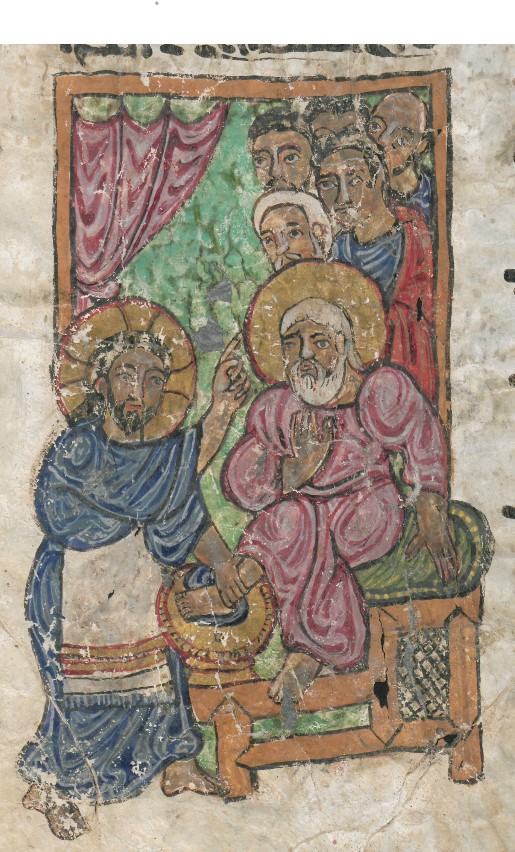
Figure 1a: Jesus washes his Disciples’ Feet. – SBB-PK: Sachau 304‑2, section of folio 89r. – Public Domain
Last Supper and Anointing of Jesus: Folio 90v (Figure 2): The scene of the Last Supper is combined with the anointing of Christ. The Last Supper scene is at the top of the page. The anointing of Christ is depicted beneath it on the right edge of the page.
The Last Supper scene is quite damaged. However, it is understood that the scene was painted on a gilded background. Christ is depicted together with his disciples around a semicircular table. Jesus on the right side of the scene is wearing a purple himation over a blue chiton. Christ has long black hair and beard and a yellow halo. Christ holds a yellow chalice with wine in his right hand. Jesus raises his left hand with his index finger pointing upwards or across. Judas, who is in the second row opposite Jesus, has his hand outstretched on the table.
The scene probably depicts the moment when Christ says, “Truly I tell you, one of you will betray me” (John 13: 21). This is why the disciples gathered around the half-round table look at Jesus with a puzzled expression.
Women at the Empty Tomb: Folio 106v (Figure 3): The scene is depicted in a rectangular frame. The upper right part of the scene is completely destroyed. The lower part of the scene depicts the moment when Mary Magdalene and Mary the mother of James meet the angel on their way to the tomb. The angel is depicted on the left, Mary Magdalene and Mary the mother of James on the right. Mary the mother of James is standing just behind Mary Magdalene.
Mary Magdalene is wearing a green maphorion over an orange dress. The green maphorion of Mary Magdalene reaches below the knee. Mary the mother of James is depicted without a halo, the same as Mary Magdalene. Mary the mother of James is wearing a blue dress. Over the dress she is wearing a purple maphorion covering her head. She is holding a censer.
The angel on the left is wearing a green himation over a blue chiton. Unlike the two other figures, the angel is depicted with a halo. The angel’s halo is yellow and his wings are purple. The angel is turned towards the two women, and his right hand is making the sign of blessing. In the background of the scene, an architectural structure with a triangular pediment is depicted. In the background, there is also a tree depicted above the angel.
Anastasis and Noli me tangere/Touch Me Not: Folio 106r (Figure 4): Anastasis and the scene „Noli me tangere/Touch Me Not“ are depicted together with the text. The illustrations are located to the right of the text. The two scenes are depicted in a green frame. The upper left part of the page is completely destroyed.
Anastasis and the scene „Noli me tangere/Touch Me Not“ are depicted together with the text. The illustrations are located to the right of the text. The two scenes are depicted in a green frame. The upper left part of the page is completely destroyed.
The scene of “Touch Me Not” is difficult to understand due to the destruction of the page. Jules Leroy describes the scene and compares it with the Anastasis scene at the bottom and determines that this scene is “Noli me tangere”, based on the textual relationship. He also states that the text on the left of the scene is the text of John 20: 11–14, in which Jesus appears to Mary Magdalene and says to her, „Do not touch me! For I have not yet ascended to the Father“, and keeps her away. However, Leroy states that there is an inconsistency in the scene order and that Mary’s encounter with Jesus should be after the “Empty Tomb” scene.
The figure on the left of the scene is wearing a gilded himation over a blue chiton. The fact that the figure in question is dressed in the same outfit as Christ depicted in the Anastasis scene below, and the connection between the scenes, suggests that this really is the „Touch Me Not“ scene. In that case, the woman on the right is Mary Magdalene and the figure on the left is Christ. Mary Magdalene on the right of the scene is wearing a purple himation over a blue garment. Mary Magdalene’s himation, which covers her head, extends to her feet.
Adam and Eve are depicted on the right of the Anastasis scene and Christ is depicted on the left of the scene, enclosed by a pink mandorla. He is wearing a gilded himation over a blue chiton. Christ’s halo is crossed and gilded, and he is stepping towards Adam and Eve.
Adam and Eve have their arms raised. Adam is dressed in green and Eve in a blue garment covering her head. Christ is holding Adam’s hand tightly. Eve reaches out to take his hand. Adam and Eve are depicted without halos.

Figure 4: Anastasis and „Noli me Tangere/ Touch Me Not“ scene. – SBB-PK: Sachau 304‑2, folio 106r. – Public Domain
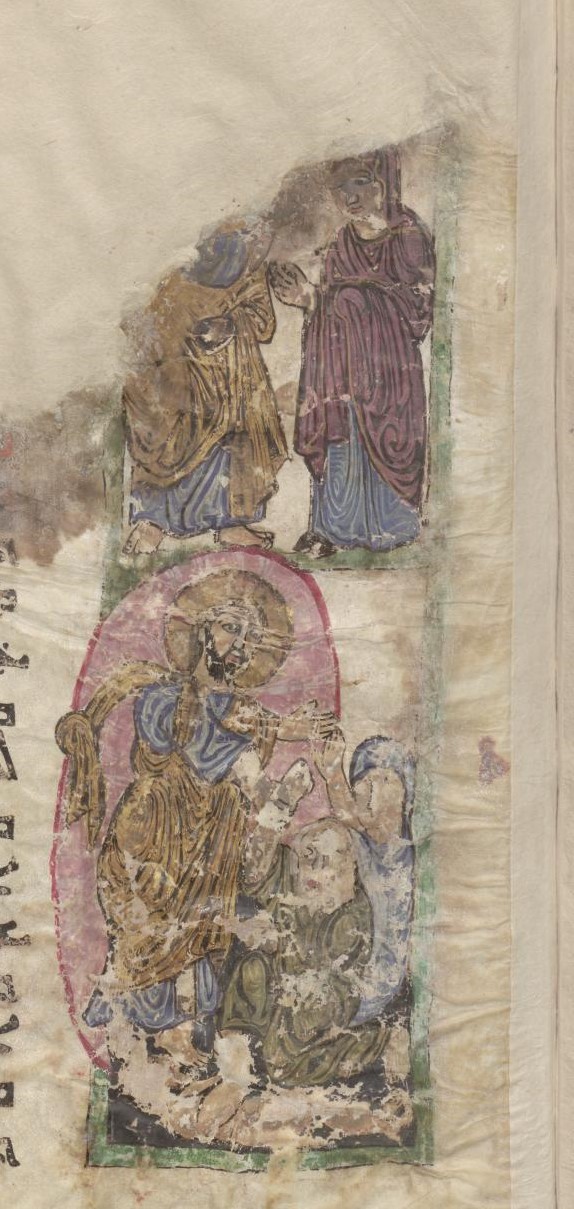
Figure 4a: Anastasis and „Noli me Tangere/ Touch Me Not” scene. – SBB-PK: Sachau 304‑2, section of folio 106r. – Public Domain
Pentecost: Folio 123v (Figure 5): The scene is depicted in a rectangular frame bounded by black contours on the inside and outside. In the scene, five apostles are depicted sitting in the foreground and the other apostles in the background.
In the center of the scene there is Peter with white hair and beard. To the right and left of Peter, both apostles have white hair and beards. The right hands of both apostles are at chest level and point upwards. However, their left hands are not visible because of their clothing. The apostle on the right is wearing a green himation over a blue chiton. Although the apostle in the right corner of the scene cannot be clearly distinguished, it can be said that he is wearing a chiton and himation in different shades of pink. The apostle in the left corner of the scene is wearing a chiton and himation in the same shades of pink as the one in the right corner. This apostle places his left hand on his knee and points upwards with his right hand. The apostles sitting in the foreground are wearing black shoes; their clothes are rhythmically varying in color.
Interrogation of the Jews and Proofing of the Crosses: Folio 162v (Figure 6): Two scenes are depicted within a green frame. These two scenes cover the entire page. The upper scene depicts a figure sitting on a gilded footstool on the right and five people on the left looking towards this figure.
The head of the seated figure on the right of the scene is missing due to damage. This figure is wearing a robe over a blue chiton (?) that reaches to his feet and red shoes. The figure closest to the one seated, a beardless young male figure, stands in a position of respect, with his hands clenched into fists. He is wearing a burgundy robe over a gilded chiton and red shoes. The other figures, barefoot, are dressed – from right to left – in green, pink, yellow and blue, respectively. The figures dressed in green and blue have black hair and beards. The other two figures have white hair and beards.
In the center of the scene at the bottom, a sleeping figure is depicted in bed, dressed in blue, with a black bushy beard. To the right of the scene, three people are to be seen pointing at the lying figure.
Leroy explains these two depictions without any inscription by linking them to the nearby text as scenes accompanying the reading for the feast of the Exaltation of the Cross.

Figure 6: Interrogation of the Jews and Proofing of the Crosses. – SBB-PK: Sachau 304‑3, folio 162v. – Public Domain
Dream of Constantine and Excavation of the Crosses: Folio 163r (Figure 7): The left side of the scene at the top of the page has been destroyed. Constantine, on a gilded ottoman, is dressed in a pink robe with black contours covering his entire body. Constantine has a yellow halo. Constantine, with a black beard, places one hand on his knee and raises the other. The scene focuses on the moment when Constantine sees the cross in his dream. Above the scene, the sky is depicted. In the center of the sky there is a gilded cross with light shining around it.
At the bottom of the page, to the right of the text, four people are depicted. The person at the top on the right is dressed in pink and the person on the left in blue. Below, the person on the right is dressed in green and the person on the left in pink. The figures are depicted without halos. The persons above hold hoes and the persons below hold tools similar to axes.

Figure 7: Dream of Constantine and Excavation of the Crosses. – SBB-PK: Sachau 304‑3, folio 163r. – Public Domain
Text, interlinear decoration
In the manuscript, the frames between the lines and the ones surrounding the chapter numbers are bordered by black contours. Many colors such as yellow, orange, pink, red, yellow-green, blue and different shades thereof are used in these frames. In general, the interlinear decoration (Figures 8 and 9) and some of the chapter number frames resemble a wicker motif. The interlinear ornaments in Syriac illustrated manuscripts are generally quite similar to each other, or even a continuation of each other.
Chapter Numbers
In the Sachau 304 manuscript, the frames decorating the chapter numbers, which were observed to be quite colorful, were found to have different geometric patterns (Figure 10). The numbers indicate the starting and ending points of each chapter. In the Sachau 304 manuscript, the frames around the beginning and end numbers of the chapters on facing pages are identical.

Figure 10: Folio 21v: end of the fourth chapter and Folio 22r: beginning of the fifth chapter. – SBB-PK: Sachau 304‑1, sections of folios 21v and 22r. – Collage: Mehmet Ali Doğan
BIBLIOGRAPHY
Leroy, J. (1964). Les Manuscrits Syriaques à Peintures : Conservés dans les Bibliothèques d’Europe et d’Orient. Paris: Librairie Orientaliste Paul Geuthner
Palmer, A. (1989). ‘The Syriac Letter-Forms of ṬūrʻAbdīn and environs’. In: Oriens Christianus 73: 68–89
Raby, Julian and Brock, S.P. (2014). ‘New Light on Syriac Painting in the Eleventh Century: Re-Dating British Library Or. 3372’. In: Eastern Christian art vol. 10 (2014/16): 33–80
Sachau, E. (1899). Verzeichnis der Syrischen Handschriften der Königlichen Bibliothek zu Berlin. Berlin: Asher (Reprint Hildesheim: Olms 2006)
Herr Mehmet Ali Doğan, Hacettepe University Ankara, war im Rahmen des Stipendienprogramms der Stiftung Preußischer Kulturbesitz im Jahr 2023 als Stipendiat an der Staatsbibliothek zu Berlin. Forschungsprojekt: „General Evaluation of the Syriac Illustrated Manuscripts, 13th Century“

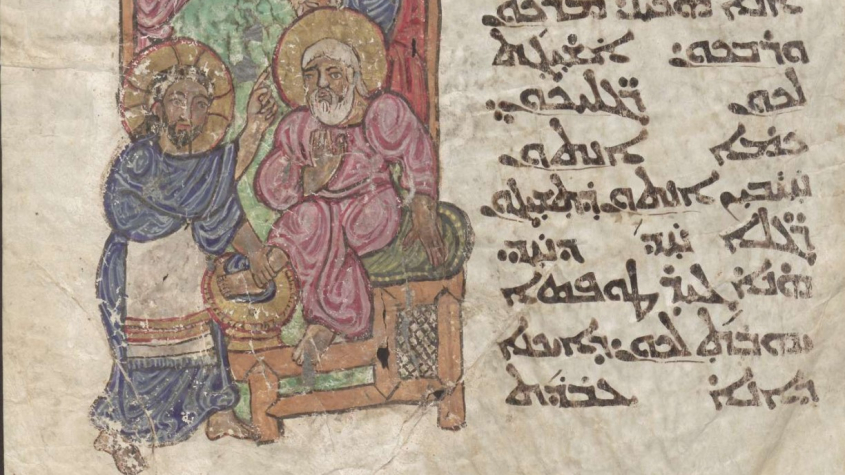 Public Domain
Public Domain





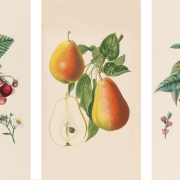
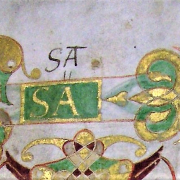 (c) Jürgen Geiß-Wunderlich
(c) Jürgen Geiß-Wunderlich . Photo: Ⓒ Linn Ahlgren/Nationalmuseum
. Photo: Ⓒ Linn Ahlgren/Nationalmuseum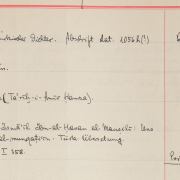 Foto: SBB-PK / CC BY-NC-SA
Foto: SBB-PK / CC BY-NC-SA Public Domain
Public Domain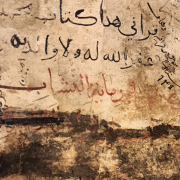 Public Domain
Public Domain
 CC BY-SA-NB
CC BY-SA-NB
Ihr Kommentar
An Diskussion beteiligen?Hinterlassen Sie uns einen Kommentar!